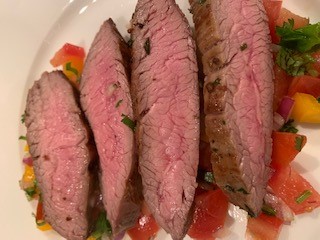
High and low heat cooking red meat? Let’s check it out!
What happens when cooking on a high heat?
Meat is made up of about 70% moisture. When you apply it to high heat most of the juices are pushed into the meat. This is what you want – to retain as much moisture inside the meat as possible. The little bit of moisture that ends up on the exterior of the meat is quickly evaporated from the high heat. Once the exterior of the meat is dry it can brown.
We want the high heat for the caramelisation – that flavour and visual appeal to the outside of your meat. You need that high heat blast to brown and flavour the exterior. Once you have achieved this then, as per my book Your Meat Mate and throughout my teaching, I have always advised to immediately STOP THE HIGH HEAT COOKING and lower the heat to gently cook the interior of your meat.
So why turn the heat to low after the high heat blast?
The lower the heat and the longer you cook your meat the more beneficial it is for the meat’s interior. You are retaining more juices, more flavour and more of its weight (hence less shrinkage) compared to cooking it on a higher heat.
Grilling and panfrying
Next time you are grilling or panfrying steaks follow the above strategy. That is high heat to brown the outside of the steak followed by low heat to gently cook until done to your liking.
Roasting
Next time you are roasting, sear the roast on the stove to brown the whole cut all over as much as possible. Once this is done place in the oven on a low heat of approx. 120 degrees C/248 degrees F. Of course, it takes longer but the benefits are greater than roasting it on a higher temperature (example 180 degrees C/356 degrees F) for a shorter time. If you roast on a low heat hence take longer to roast, then the roast will be more tender, more flavourful hold more of its juices hence more of its weight (which is important from a commercial point of view) and it will be easier to carve.
DO NOT start the roast on a high heat in the oven (for example 250 degrees C/480 degrees F) to brown (followed by lowering the heat).
Why?
Because you won’t achieve such an effective browning. You need the fierce heat from the stove to achieve that caramelisation to the exterior of the roast. The highest heat from the oven is just not fierce enough to do it.
Braising
Next time you are braising, brown the meat on the high heat on the stove followed by low heat/longer cooking in the oven. Braising, being a moist heat cooking method (roasting, grilling and pan frying are dry heat cooking methods) the liquid (the sauce in which the meat is cooking) is a better heat conductor than air. It means that the moist heat penetrates the meat quickly. Therefore, to avoid over cooking in the oven, meat should be simmered, never boiled.
But there are 2 reasons to use high heat only:
- If you are grilling or panfrying a minute steak, you would use the high heat to sear one side to brown, turn the steak over to sear the other side until browned, then immediately remove from the pan. The intention is to give the high heat no time to penetrate the interior of the steak. The steak is just so thin that high heat only (and no lowering the heat) is the most suitable and fastest method to cook it. That’s why it is called a minute steak!
- If you are roasting eye fillet. The distance between the exterior and interior is very small. This cut should be placed in the oven on a very high heat approx.180 – 200 degrees C (350 – 400 degrees F) for a short period to reduce meat shrinkage. The idea is to achieve a well – browned flavoured exterior and a rare to medium – rare interior. The eye fillet is extremely tender as well as thin so this kind of roasting is perfect for this cut.
Cooking red meat, regardless of the cut or the cookery method is not an exact science. I am not comfortable giving exact times, temperatures and weights because no two cuts of meat are the same. Neither are all the hotplates, grills, stove tops and ovens. For example in the oven the heat is different depending on which shelf the meat is placed on and also whether the oven is fan forced or not.
However, understanding how and why high and low heat cooking of red meat can work together (aside from the 2 exceptions listed above) will surely put you in the best position to cook your meat to perfection – regardless of the cut or the cookery method.
Good luck on your meat cooking journey.
For more on cooking red meat please visit www.yourmeatmate.com
